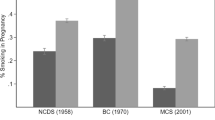Abstract
This research note combines two national Taiwanese data sets to investigate the relationships among low birth weight (LBW) babies, their parents’ educational levels, and their future academic outcomes. We find that LBW is negatively correlated with the probability of such children attending college at age 18; however, when both parents are college or high school graduates, such negative effects may be partially offset. We also show that discrimination against daughters occurs, but only for daughters who were LBW babies. Moreover, high parental education can buffer the LBW shock only among moderately LBW children (as compared with very LBW children) and full-term LBW children (as compared with preterm LBW children).
Similar content being viewed by others
References
Almond, D., K. Chay, and D. Lee. 2005. “The Costs of Low Birth Weight.” Quarterly Journal of Economics 121:1031–83.
Becker, G. 1981. A Treatise on the Family. Cambridge, MA: Harvard University Press.
Behrman, J. and M. Rosenzweig. 2004. “Returns to Birth Weight.” Review of Economics and Statistics 86:586–601.
Boardman, J.D., D.A. Powers, Y.C. Padilla, and R.A. Hummer. 2002. “Low Birth Weight, Social Factors and Development Outcomes Among Children in the United States.” Demography 39:353–68.
Bonjour D., L.F. Cherkas, J.E. Haskel, D.D. Hawkes, and T.D. Spector. 2003. “Returns to Education: Evidence From U.K. Twins.” American Economic Review 93:1799–812.
Breslau, N., J.E. DelDotto, G.G. Brown, S. Kumar, S. Ezhuthachan, K.G. Hufnagle, and E.L. Peterson. 1994. “A Gradient Relationship Between Low Birth Weight and IQ at Age 6 Years.” Archives of Pediatric and Adolescent Medicine 148:377–83.
Brinton, M. 1988. “The Social-Institutional Bases of Gender Stratification: Japan as an Illustrative Case.” American Journal of Sociology 94:300–34.
—. 1993. Women and the Economic Miracle: Gender and Work in Postwar Japan. Berkley, CA: University of California Press.
Conley, D. and N. Bennett. 2000. “Is Biology Destiny? Birth Weight and Life Chances.” American Sociological Review 65:458–67.
Currie, J. and R. Hyson. 1999. “Is the Impact of Health Shocks Cushioned by Socioeconomic Status? The Case of Low Birth Weight.” American Economic Review 89:245–50.
Greenhalgh, S. 1985. “Sexual Stratification: The Other Side of ‘Growth With Equity’ in East Asia.” Population and Development Review 11:265–314.
Hack, M., D. Flannery, M. Schluchter, L. Carter, E. Borawski, and N. Klein. 2002. “Outcomes in Young Adulthood for Very Low Birth Weight Infants.” New England Journal of Medicine 346(3):149–57.
Kandel, E. and S.A. Mednick. 1991. “Perinatal Complications Predict Violent Offending.” Criminology 29:519–29.
McCormick, M.C., J. Brooks-Gunn, K. Workman-Daniels, J. Turner, and G.J. Peckham. 1992. “The Health and Developmental Status of Very Low Birth Weight Children at School Age.” Journal of the American Medical Association 267(16):2204–208.
Parish, W.L. and R.J. Willis. 1993. “Daughters, Education and Family Budgets—Taiwan Experiences.” Journal of Human Resources 28:863–98.
Perlman, J. 2001. “Neurobehavioral Deficits in Premature Graduates of Intensive Care—Potential Medical and Neonatal Environmental Risk Factors.” Pediatrics 108:1339–48.
Raine, A., P. Brennan, and S.A. Mednick. 1994. “Birth Complications Combined With Early Maternal Rejection at Age 1 Year Predispose to Violent Crime at Age 18 Years.” Archives of General Psychiatry 51:984–88.
Tibbetts, S. and A. Piquero. 1999. “The Influence of Gender, Low Birth Weight and Disadvantaged Environment in Predicting Early Onset of Offending: A Test of Moffitt’s Interactional Hypothesis.” Criminology 37:843–77.
Yu, W.H. and K.S. Su. 2006. “Gender, Sibship Structure, and Educational Inequality in Taiwan: Son Preference Revisited.” Journal of Marriage and Family 68:1057–68.
Author information
Authors and Affiliations
Additional information
We are grateful for the valuable comments by two anonymous referees and the editors. All remaining errors are ours.
Rights and permissions
About this article
Cite this article
Lin, MJ., Liu, JT. & Chou, SY. As low birth weight babies grow, can well-educated parents buffer this adverse factor? A research note. Demography 44, 335–343 (2007). https://doi.org/10.1353/dem.2007.0013
Issue Date:
DOI: https://doi.org/10.1353/dem.2007.0013




